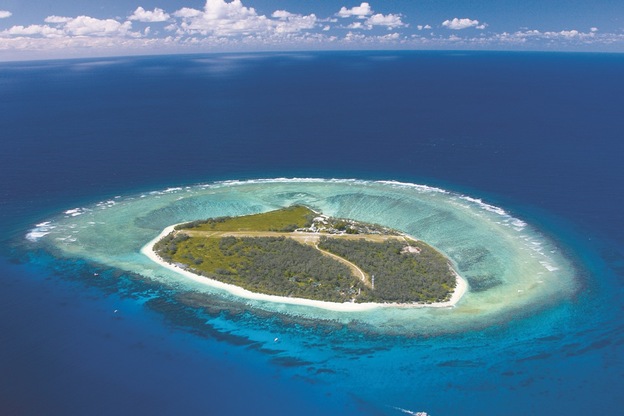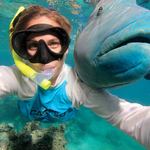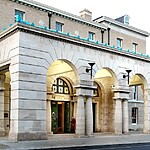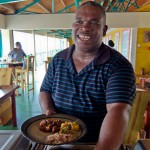Famous for seasonal whale watching, Lady Elliot Island a 3,500 year old coral cay is among the most pristine and untouched sections of the Great Barrier Reef.
Our small glass bottom boat is bobbing up and down like a cork over the ocean swell when the skipper jumps for joy shouting “we’ve got one, there’s two now… wow! Just look at them go”.
Assorted wet suit and life jacket encased bodies jump up for a view, cameras are drenched, flippers and masks sent flying in the excitement of witnessing a gigantic splash followed by a smaller one nearby.
A mere couple of lengths of the boat away a mighty humpback whale, up to 18 metres long, weighing from 30 to 40 tons and her calf rear up. Then mother rolls in what’s known as a “breach” an astonishingly elegant performance, showing a flash of tail before disappearing into the depths.

Our engine is turned off and we drift a bit, rewarded a few minutes later by a second sighting.
Here in waters on the southern tip of Australia’s Great Barrier Reef thousands of humpback whales and their newborn begin one of the planet’s longest and most intriguing migrations.
Having given birth and eaten their fill in the tropical waters off Northern Queensland they are on the return leg of a 10,000 km annual round trip back to Antarctica.

Lady Elliot Island lies one and a half hours by light aircraft from Queensland’s Miami like Gold Coast, south of Brisbane. It is a world away from luxury high rise hotel complexes and glitzy shopping malls on the Gold Coast strip now all the busier thanks to ever more development and a light rail link along the coast.
At first glance from the air Lady Elliot resembles a castaway paradise island. Our Cessna circles, taking in the fabulous view before we land effortlessly in a grass clearing on one of the world’s shortest airstrips.
A bleached white coral shore bordering a crystal clear sea shaded from pale Aquamarine to Emerald gives way to lush tropical vegetation concealing simple pastel coloured timber buildings on the island which can be walked coast to coast in an hour.

Our pilot Matt who has taken us on a thrilling journey in the single engine plane soaring over the southern Queensland coast reminds passengers to look out for the unrivalled population of Manta rays and turtles among the 1500 species of marine life here.
We don flippers and snorkel masks, preparing to awkwardly hoist ourselves off the boat dive platform and plonk into the swell after the humpback whales vanish when guide Kim points to a big menacing looking triangular shadow just below the surface.
“That will be a manta ray” she explains, “harmless and shy, so nothing to worry about”.
We are to snorkel at one of the island’s many reef locations, chosen with tides and experience of snorkelers in mind. This one is called ‘Second Reef’ to the west of the island.

Once in, I am instantly transported inside a giant aquarium. There are 350 known species of hard corals on the increasingly fragile and over snorkelled and dived Great Barrier Reef which begins at Lady Elliot stretching over 2,000 kms north almost to the coast of New Guinea.
Dramatic formations of different corals abound from boulders, canyons, and immense tree like branches to towering peaks and squatting moonscapes. The millions of years old coral reef reminds me cartoon pictures of a bustling city that never sleeps – the buildings made of coral with countless marine inhabitants constantly coming and going.
Nothing prepares you for this underwater fantasy world and cascading jewel box of marine creatures that inhabit it. I had expected to admire a few passive enlarged versions of tropical tank fish you might find in zoos or your local dentistry clinic put there to calm the patients down, not this teaming kaleidoscope of colour weaving in and out of the coral.
Some species like the scissortail sergeants travel in disciplined schools. Others are individualists, a few shy the majority curious. The brilliantly coloured emperor angelfish scouts alone. Belying his beauty and serene appearance the parrot fish is in fact a nasty bully. Sinister residents like the Moray Eel thankfully stay close to the bottom.

Two giant thick lipped Groupers swim up to eyeball me. There is no sign of another regular inhabitant, the reef shark nor any identifiable shark species, though one of our snorkelers has seen a young shark and taken underwater photos.
A few of us have heard a strange whistling noise interspersed with an echo like boom which turned out to be humpback whales “talking and singing”, Kim who has also heard them confirmed.
Two large green turtles, crazy paving patterns on their shells are the absolute highlight of my snorkel adventure, gently swimming and, delicately grazing off plants clinging to the reef only a few feet below..
Back on land again adults and excited children explore the shoreline and luke warm paddling pools around Lady Elliot’s 0.4 km broad terrain,wearing the supplied reef shoes as protection from sharp coral shingle,

Over 30 varieties of birds live on the island which was created by bird droppings over thousands of years. The birds, who have no predators seem to instinctively know the island belongs to them happily share their space with all human arrivals, explains Japanese born Yuji Sasaki one of Lady Elliot’s team of expert eco guides.
Meals on Lady Elliot Island are substantial buffets of seafood and other dishes, included in the price of your visit. Accommodation ranges from larger family bungalows to no frills cabins which blend into the natural terrain. Visitors (limited to 150 maximum at any one time) share our diving, snorkelling and dolphin spotting stories. We know we are privileged to be here. The Island’s history and ecology is explained by Lady Elliot Resort staff who also organize night time reef exploration and snorkelling, walks to special turtle nesting spots and other activities.

Yuji urges me to step off the beach and try some ‘reef walking’ in the tidal lagoon. Using long walking sticks to keep our balance we wade knee deep while the guide points out strange creatures, from sea cucumbers to the bizarre sea hare who fertilizes and impregnates itself. At night the soft coral comes eerily alive and creepy tentacles reach out to trap and catch microscopic organisms that were safe from daytime predators.
Later we lounge on deck beds on the beach enjoying one of the most tranquil and chilled spots anywhere. An island bird, the White Capped Noddy perches inches away from my face, sharing the view of the shimmering sunlit lagoon and surge of foamy waves on the horizon.

The Lady Elliot Island Great Barrier Reef all inclusive day trip is the only one of its type in Australia. The visit allows you to view one of the most pristine sections of Australia’s Great Barrier Reef from the air as well as from above and below the water all in one day.
Tell me more about Lady Elliot Island
Getting to Lady Elliot Island : Daily flights from Hervey Bay/Fraser Coast or Bundaberg accessed from Brisbane, the Gold Coast and other points. Prices ex Bundaberg Adult $ AU 3645 (€257) child $210 (€147.
Every day except Christmas day #ladyelliotisland, including snorkelling, glass bottom boat tours, equipment, buffet lunch, fish feeding, reef walks and other activities. #ladyelliotisland See www.ladyelliot.com.au Also overnight and longer stays bookings. More information on the Great Barrier Reef see www.queensland.com






